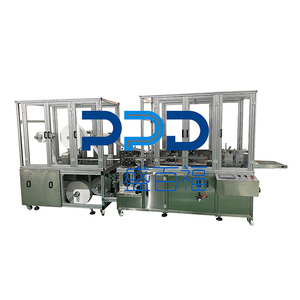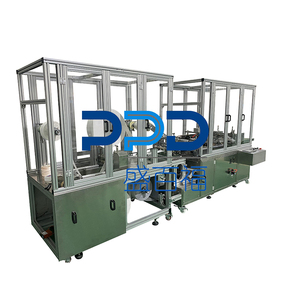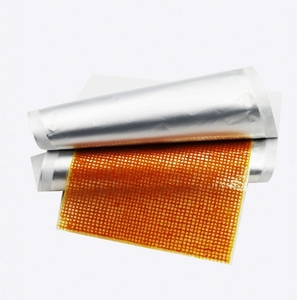
All categories
Featured selections
Trade Assurance
Buyer Central
Help Center
Get the app
Become a supplier

(1006 products available)














A wound dressing making machine helps to manufacture different types of wound dressings like gauze rolls, nonwoven swabs, adhesive bandages, and others. Here are some types of machines for making various kinds of wound dressings:
Gauze Roll Machine:
This machine produces gauze rolls using cotton or cotton-blended yarn. It weaves the yarn into a lightweight, porous fabric. The fabric is then automated into gauze rolls. Some machines can adjust the width and length according to customer needs.
Nonwoven Swab Machine:
Using nonwoven fabric as raw material, these machines can produce swabs or pads that absorb liquid. They often have the ability to laminate, emboss, and cut nonwoven fabrics into specific shapes and sizes, which can fulfill different clinical and medical requirements.
Adhesive Bandage Dressing Machine:
This machine offers a complete production line for adhesive bandages. From cutting the base material to applying the adhesive and attaching the backing paper, it can automatically perform all these processes. Some models even provide distinct shapes and sizes by using the die-cutting technique.
Hydrocolloid Dressing Production Machine:
These machines foster hydrocolloid dressings by way of extrusion or coating methods to apply hydrocolloid substances onto the protective layer or composite layer. Such machines can produce dressings with different plasticizers, colors, and viscosities.
Foam Wound Dressing Machine:
The machine aids in manufacturing foam dressings using polyurethane or polyvinyl acetate through the processes of cutting, laminating, and assembling various material layers.
Woven Swab Machine:
This woven swab machine is designed to manufacture swabs made from woven fabrics, commonly used for medical and hygienic purposes. It weaves strong and absorbent fabrics directly, dispensing the need for excessive raw material handling. Advanced functions enable automatic cutting, counting, and packaging, thereby enhancing production efficiency.
Embossed Film Dressing Machine:
This machine can manufacture embossed film dressings by means of embossing and cutting techniques, combining different backing and absorbing materials to meet diverse clinical needs.
Automatic Wound Dressing Machine:
Automatic machines can manufacture a wide range of wound dressings, including but not limited to nonwoven, gauze, foam, silicone gel, hydrocolloid, and composite dressings. Such machines commonly employ an automatic control system to realize the whole production process—from material feeding, shaping, and cutting to packing—thereby boosting production efficiency and precision.
Wound dressing manufacturing machines usually have the following specifications.
How to maintain the wound dressing manufacturing machine :
When purchasing a machine that manufactures dressing pads for injuries, buyers should consider several factors. This includes the types of materials the machine can work with and whether it can produce various kinds of dressings. Also, buyers should evaluate the machine's production speed and efficiency. Ideally, the machine's settings should be easily adjustable for quick changeovers whenever the production needs go up or down.
The machine should meet all quality and safety standards set by the relevant organizations. Overall, the end products should be of excellent quality, implying that the machine should have features that meet quality control standards. Check whether the machine has automatic quality control mechanisms that can detect flaws and correct them immediately.
The wound dressing making machine should be easy to operate, and its instructions should be clear. It should also have essential features that ensure the operator's safety. When learning how to operate the machine, the operator should spend the least amount of time possible. This means that the machine should not have parts that are hard to understand.
An efficient machine will effectively utilize resources. It should be energy efficient so that the business does not incur unnecessary costs. At the same time, the machine should be made of durable materials that require minimal maintenance and are cost-effective. Before purchasing, buyers should consider the amount of maintenance and repair the machines will need.
Consider the type of wound dressing products buyers intend to produce and your business model's specific requirements. Opt for machines that manufacturers offer after-sale services like training and technical support. This will save the business the hassle of looking for independent professionals to offer repair and maintenance services. The supplier's reputation and reliability are essential, so take time to look at their reviews and ratings.
Q1: How does a nonwoven sterile dressing supply machine work?
A1: The machine performs three key functions—forming, filling, and sealing. It uses a roll-fed fabric technique to make the pads or dressings' shapes. Sterile absorbent cotton or gauze is automatically fed into the shaped fabric to fill the formed shapes. Finally, the filled fabric is sealed with heat or adhesive, and the sealed wound dressings are cut into individual pieces.
Q2: How can bulk production of wound dressings help buyers?
A2: In the medical sector, there is an ever-increasing demand for wound dressings each day. Wholesale buyers can supply hospitals and clinics that need to use these wound dressings daily during their patients' treatments. The ability to produce large quantities means that wholesale buyers can serve more retail buyers, thus increasing their sales.
Q3: Is it easy to operate a wound dressing making machine?
A3: Yes, it is easy to operate. Most of them come with a controller that is easy to set and understand. Some machines have an automatic alarm system that notifies the operator if there is a problem with the dressing being produced or else.
Q4: What type of fuel is consumed by a wound dressing making machine?
A4: The machine uses electric power in volts. Small machines use 110-220V, but larger industrial machines can use anywhere from 380V to 1000V.
Q5: What are some uses of non-woven fabrics in the medical field?
A5: Non-woven fabrics are used in the medical field to make surgical gowns, surgical drapes, disposable patient blankets, infusion sets, sterilization wraps, masks, and wound dressings, to name a few.